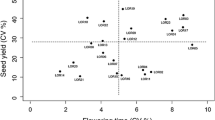Abstract
Because Medicago ruthenica [(L.) Ledebour] is a potential new forage legume, we collected 90 accessions in Inner Mongolia in 1991. The 40 accessions evaluated in this study (E2) trace to 13 collection sites ranging from 40° 40′ (N) × 111° 15′ (E) to 42° 55′ (N) × 122° 20′ (E) and to altitudes ranging from 175 to 1493 m. Nineteen of these accessions were collected from new or under-represented sites in generally milder and drier climates (temperate desert steppes), compared to the 50 accessions evaluated earlier (E1). All accessions were evaluated at Beltsville, MD (USA) on a B and K deficient Iuka sandy loam (coarse-loamy, siliceous, acid, thermic, Aquic Udigluvent; pH 6.4) in two-year studies. Significant variation was noted in E1 and E2 for dry matter yield, growth habit, leaf shape, and plant height and width. Upright growth habit and leaf narrowness, and procumbency and yield were positively correlated in both evaluations, but no particular leaf shape or growth habit was correlated with tolerance to winter conditions. In E2, leaf:stem ratios of four M. ruthenica accessions and a cultivated alfalfa (M. sativa L.) check were not significantly different, but M. ruthenica was significantly more tolerant of potato leafhopper (Empoasca fabae Harris) feeding than was M. sativa. Second-year alfalfa dry matter yield was about five times larger than that of M. ruthenica. Many of the highest yielding accessions were collected near cultivated fields and/or buildings. Although data for both evaluations demonstrated the same basic trends, there were sufficient deviations to emphasize the value of evaluating the entire germplasm collection.
Similar content being viewed by others
References
Balabaev, G.A., 1934. Yellow lucernes of Siberia, Medicago ruthenica (L.) Lebd. and M. platycarpos (L.) Lebd. Bull. App. Bot. Genet. Plant Breeding Service 7: 113–123.
Barnes, D.K., B.P. Goplen & J.E. Baylor, 1988. Highlights in the USA and Canada. In: Hanson A. A., D. K. Barnes & R. R. Hill (Eds.), Alfalfa and Alfalfa Improvement. Agronomy Monograph 29. American Soc. of Agronomy, Madison, WI, USA, pp. 1–24.
Campbell, T.A., G. Bao & Z.L. Xia, 1997. Agronomic evaluation of Medicago ruthenica collected in Inner Mongolia. Crop Sci. 37: 599–604.
Lanyon, L.E. & W.K. Griffith, 1988. Nutrition and fertilizer use. In: Hanson, A.A., D.K. Barnes & R.R. Hill (Eds.), Alfalfa and Alfalfa Improvement. Agronomy Monograph 29. American Soc. of Agronomy, Madison, WI, USA, pp. 333–372.
Lesins, K.A. & I. Lesins, 1979. Genus Medicago (Leguminosae) A Taxogenetic Study. W. Junk, The Hague.
SAS Institute, 1989. SAS/STATTM Guide for Personal Computers, Version 6.1., 4th. ed. vol 2. SAS Inst., Cary, NC, USA.
Sinskaya, E.N., 1961. Flora of Cultivated Plants of the USSR. XIII. Perennial Leguminous Plants. Part I. Medic, Sweet clover, Fenugreek. Israel Program for Scientific Translations, Jerusalem.
Small, E. & M. Jomphe, 1989. A synopsis of the genus Medicago (Leguminosae). Can. J. Bot. 67: 3260–3294.
Author information
Authors and Affiliations
Rights and permissions
About this article
Cite this article
Campbell, T.A., Bao, G. & Xia, Z.L. Completion of the agronomic evaluations of Medicago ruthenica [(L.) Ledebour] germplasm collected in Inner Mongolia. Genetic Resources and Crop Evolution 46, 477–484 (1999). https://doi.org/10.1023/A:1008730322306
Issue Date:
DOI: https://doi.org/10.1023/A:1008730322306




